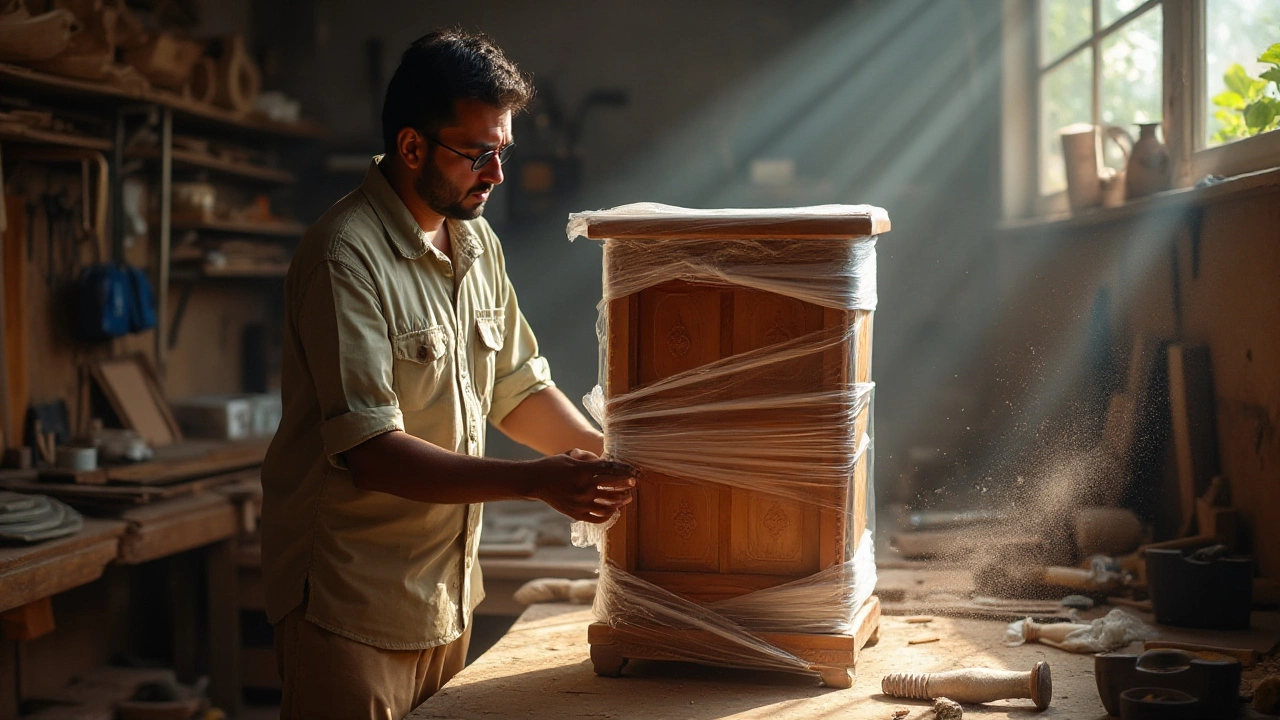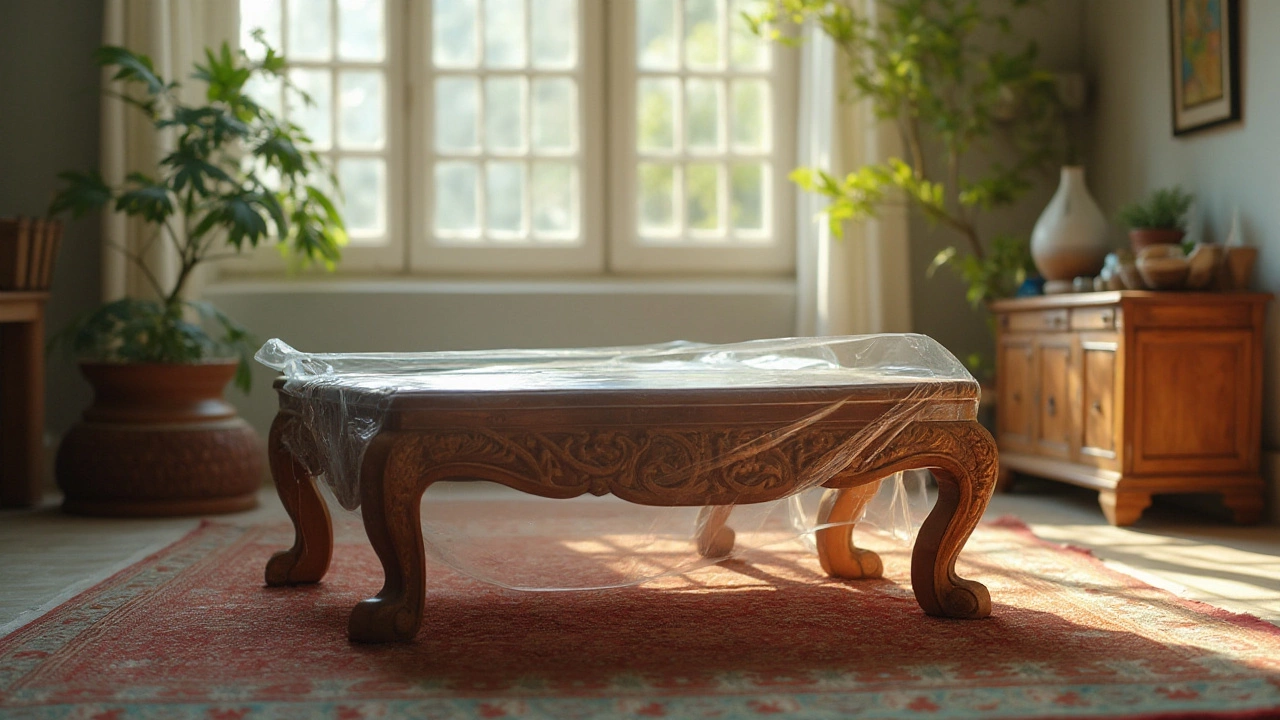Storing furniture can be a bit of a puzzle, especially when it comes to choosing the right protective measures. One popular option that often comes up is wrapping furniture in plastic. But is it really the best choice?
In this article, we delve into the ins and outs of using plastic for furniture storage. From the potential benefits, such as moisture resistance and ease of use, to the possible drawbacks, like trapping humidity, there's a lot to consider. We'll guide you through techniques to ensure your furniture stays in tip-top condition while in storage.
So whether you're moving, downsizing, or simply trying to free some space at home, read on to find out how best to protect your prized belongings and explore alternatives that might just suit your needs better.
- Understanding Plastic Wrapping's Benefits and Drawbacks
- Steps to Shield Furniture Effectively
- Avoiding Common Mistakes in Furniture Storage
- Smart Alternatives to Plastic for Long-Term Storage
Understanding Plastic Wrapping's Benefits and Drawbacks
When it comes to storing furniture, many people turn to plastic wrapping as a solution for its simplicity and convenience. The promise of a barrier against dust, dirt, and moisture can be compelling. Particularly when dealing with long-term storage needs, the notion that your pieces will emerge as pristine as when they went in can make a convincing argument for the use of plastic wrapping. But it’s not without its drawbacks.
The benefits are straightforward: wrapping your cherished sofa or antique coffee table in plastic can indeed keep out dust and protect from surface scratches. Indeed, if moisture levels in the storage area are reasonably low, plastic wrapping can help maintain the finish of wooden pieces by shielding them from accidental scuffs or the grime of disuse. For upholstered items, a plastic wrap can keep pests like moths, which are known to ruin fabrics, at bay.
However, it’s crucial to ponder the disadvantages as well. Plastic is non-breathable, and this quality can lead to moisture being trapped inside, especially in humid storage conditions. Such trapped moisture can result in more damage than good, leading to the growth of mold and mildew, particularly on organic materials like wood and fabric. It's often recommended to include a layer of breathable material beneath the plastic to mitigate this risk.
"It's important to consider the environment where the furniture is stored," says Angela Barker, a consultant from Furniture Care Australia. "While plastic shields against visible dirt, it can exacerbate internal damage if humidity is a factor."
Without the proper considerations, long-term storage in plastic could potentially warp wood and cause finishes to cloud—a perilous outcome for valuable antiques. Additionally, plastics often contain chemicals that might interact unfavorably with certain materials over extended periods, leading to discoloration or degradation.
In essence, while plastic wrapping offers protection and ease of use, it's imperative for furniture owners to assess their specific storage environment and take complementary steps to ensure the safety and longevity of their items. Knowing both the positives and the potential pitfalls allows for a more informed decision, ensuring your furniture remains protected during its stint in storage.

Steps to Shield Furniture Effectively
When embarking on the task of storing your beloved pieces, ensuring they are shielded effectively becomes paramount. The first step in this endeavor is carefully selecting the materials you will use for wrapping. Not all plastics are created equal, and opting for breathable options is crucial in preventing mold and mildew. Wrapping your furniture tightly might seem like a smart move, yet it can create a micro-environment where moisture becomes trapped, wreaking havoc on wood and fabrics alike. A good practice is to wrap looser, thus allowing for some air circulation.
Next, before wrapping, clean each piece thoroughly. Even the slightest dust or grime can become abrasive over long periods, acting like sandpaper under the wraps. A damp cloth and a gentle cleaner suitable for your furniture type do wonders. Remember to ensure all pieces are completely dry after cleaning to avoid locking in moisture. It's here that an ounce of prevention becomes worth a pound of cure in anticipating issues linked to trapped humidity.
A layer of protection is often a good idea prior to applying plastic. Consider covering more sensitive surfaces with moving blankets or old sheets first. Not only do these add another layer between the plastic wrapping and your furniture, but they also pad the surfaces against potential scratches during handling and transportation. Additionally, using corner protectors for tables and larger pieces can fend off unwanted knocks and dents.
Consider lifting furniture pieces off the ground when possible. Elevating your items on pallets or blocks can prevent damage from any unexpected moisture on the storage unit floor. Climactic conditions vary greatly, and despite all precautions, an unexpected leaking roof or condensation might pop up as unwanted surprises. Moreover, it assists in reducing pressure points on legs and base supports, keeping structural integrity intact over time.
Finally, when placing your furniture in storage, leave gaps between pieces. Piling items can lead to inadvertent damage and restrict proper airflow. This layout prevents pressure build-up and further deflects potential issues ranging from scratches to attributes. According to experts, "Even the most durable of furniture pieces need room to breathe, much like a healthy forest standing resilient through seasons." By thinking strategically about layout from the start, you'll save yourself considerable headaches when retrieving your goods in optimal condition.

Avoiding Common Mistakes in Furniture Storage
When it comes to storing your precious pieces, mistakes can easily be made, often costing more in preservation than in the actual storage. A prevalent error is the hasty choice to enclose furniture completely in plastic. While using plastic undoubtedly offers some advantages, such as protecting against dust and grime, it is not a miraculous shield for all furniture types. Plastic tends to trap moisture if the furniture isn't completely dry before wrapping, and this can lead to mildew and unsightly mold patches, especially on wooden surfaces. It's vital to prepare furniture meticulously before storage, ensuring each item is dry, clean, and conditioned with appropriate treatments to limit these risks.
Avoid placing too much trust in just the plastic covering without considering the storage environment. It often happens that people overlook the climate of the space where furniture will be kept. Climate-controlled storage is a boon for furniture that’s sensitive to extreme temperatures or humidity. If you choose an uncontrolled environment, even the best wrap job won't be enough to counteract cracking, warping, or rusting. In this regard, metal pieces suffer immensely from humidity and can corrode if not handled suitably before wrapping them in plastic.
The National Trust for Historic Preservation mentions, "Proper environmental control is key to ensuring the longevity of stored items," highlighting the importance of the right storage choice beyond just wrapping methods.
Another common mistake is neglecting the foundational base where furniture sits during storage. Direct contact with concrete floors can spell disaster because concrete can absorb moisture from the environment, sending it upwards into the wood or fabric through capillary action. Using pallets or wooden planks underneath can prevent such moisture wicking, providing an elevated barrier between your furnishings and the ground. It's a simple trick but tremendously effective in keeping them safe from unseen hazards.
Packing methodologies also matter greatly. Not padding your items adequately or forgoing corner protections invites unnecessary dents, scratches, and even breaks. While plastic wrapping can hold things together, movements during the moving process can shift items around, causing friction and damage. It's worth investing in bubble wrap, quilted pads, or blankets that safeguard fragile pieces and reduce impacts. This layering effect not only defends against physical damage but also acts as a blanket for temperature regulation.
To wrap up, knowing how to effectively store furniture involves more than just throwing a sheet of plastic over it. Educating yourself about the materials involved and the storage environment can be valuable and time-saving, providing a peace of mind solution that balances protection properly.

Smart Alternatives to Plastic for Long-Term Storage
When considering furniture storage for the long haul, turning away from plastic does not mean you're left without effective options. In fact, exploring different materials and methods can often lead to better preservation of treasured pieces. Natural fabrics, for instance, serve as an excellent alternative. Breathable cotton sheets or drop cloths can be draped over furniture to shield them from dust while allowing airflow, which is vital for preventing moisture build-up. This method is particularly advantageous for materials like leather and wood, which need to 'breathe' to maintain their integrity. Remember, ensuring your furniture is clean and dry before covering is paramount, as even the most breathable fabrics can't correct trapped dirt or moisture.
A climate-controlled storage environment is one of the most reliable companions in your quest for preserving furniture effectively. Such facilities regulate both temperature and humidity levels, creating a stable setting that mitigates the risks posed by the extremes of weather. If you opt for such a facility, sometimes simply positioning your furniture properly – away from direct sunlight or other fixtures that may snag – coupled with breathable coverings, can be all it requires. An organized layout also promotes safety, so each piece remains unscathed. The additional expense of climate control might seem unnecessary at first, but it swiftly pays for itself by averting potential damage costs.
When it comes to wrapping options, quilted furniture covers may not cross as many minds, yet they are excellent alternatives to rigid plastics. These covers not only add a protective layer against physical stress but also provide cushioning – a boon during transit or in stacked storages. The snug fit of padded covers is particularly beneficial for odd-shaped or delicate pieces, ensuring that they remain intact even during unexpected shifts. Opting for covers designed specifically for particular types of furniture can amplify their effectiveness; for instance, custom-fit covers for sofas or chairs are designed to envelop corners and crevices, giving total coverage.
For those who prefer a more eco-conscious approach, there are biodegradable wraps made from natural starches or recycled paper. These alternatives are gaining popularity for being both effective and environmentally friendly. They're a fitting choice for those who shun plastic due to ecological concerns. Using these wraps means contributing less to your carbon footprint while effectively keeping dust and small pests at bay, proving that conscientious choices can still meet practical needs. Notably, they often come in perforated versions for added breathability – a key convenience for items that are in long-term storage.
Wooden crates, though an ancient method, are another outstanding choice for furniture storage. Known for their sturdiness, crates offer unwavering support and protection against physical damage. When properly sealed, they also shield against dust and pests. In professional storages, wooden crates can be lined with a plethora of materials like acid-free tissue paper to prevent scratches. They are extremely effective for high-value items, such as antique furniture, that demand extra care. If you opt for this path, engage professionals to guarantee the crates are assembled to perfection and correctly sealed, providing consistent security.
As highlighted by furniture conservator Dr. Nathaniel Martin,
"The way you wrap and store your goods should always be dictated by the materials used in your furniture and their respective vulnerabilities rather than a one-size-fits-all approach."This wisdom speaks volumes, as understanding the nuances and needs of your furniture can lead to markedly better outcomes. As stewards of your possessions, considering all aspects including environmental features and personalized requirements can help you make smart choices that prolong the beauty and usability of your cherished pieces.

